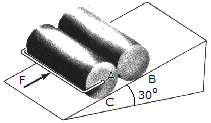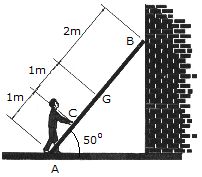Engineering Mechanics - Friction
- Friction - General Questions

The boy at D has a mass of 50 kg, a center of mass at G, and stands on a plank at the position shown. The plank is pin-supported at A and rests on a post at B. Neglecting the weight of the plank and post, determine the magnitude of force P his friend (?) at E must exert in order to pull out the post. Take  B = 0.3 and
B = 0.3 and  C = 0.8.
C = 0.8.

A uniform beam has a mass of 18 kg and rests on two surfaces at points A and B. Determine the maximum distance x to which the girl can slowly walk up the beam before it begins to slip. The girl has a mass of 50 kg and walks up the beam with a constant velocity.

Determine the minimum force F needed to push the two 75-kg cylinders up the incline. The force acts parallel to the plane and the coefficients of friction at the contacting surfaces are  A = 0.3,
A = 0.3,  B = 0.25,
B = 0.25,  C = 0.4. Each cylinder has a radius of 150 mm.
C = 0.4. Each cylinder has a radius of 150 mm.

The refrigerator has a weight of 200 lb and a center of gravity at G. Determine the force P required to move it. Will the refrigerator tip or slip? Take  = 0.4.
= 0.4.

A 17-kg ladder has a center of mass at G. If the coefficients of friction at A and B are  A = 0.3 and
A = 0.3 and  B = 0.2, respectively, determine the smallest horizontal force that the man must exert of the ladder at point C in order to push the ladder forward.
B = 0.2, respectively, determine the smallest horizontal force that the man must exert of the ladder at point C in order to push the ladder forward.